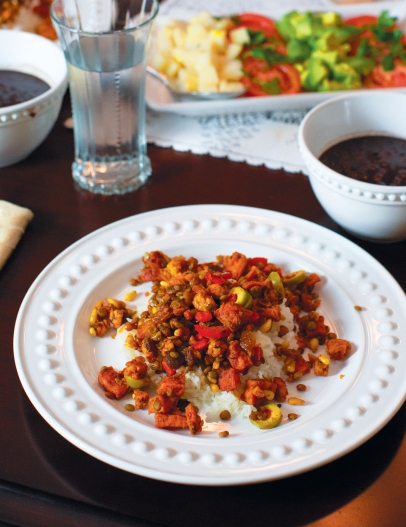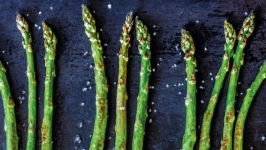Cuban Sin Carne - Cuban Food Vegan Style
Where contributor Jessica Lopez finds her vegan--and Cuban--inspiration around Philly.
In the Spring 2019 issue, contributor Jessica Lopez shared the story of how she maintained her family's Cuban culinary heritage even as she adopted a plant-based diet. You can read her essay and recipes here. Since the piece was published, Lopez answered some questions from editor Joy Manning about what Cuban restaurants are her favorites, where she shops for ingredients, and how anyone can make their own family's traditional dishes a bit healthier.
JM: You wrote so beautifully about the homemade Cuban food of your family in your article. I'm wondering if there are any restaurants you recommend for people who want to get a taste of the cuisine but aren't into cooking at home. Do you have any favorite Cuban restaurants?
JL: One of my family’s favorite places to go is Mixto in Washington Square West. My dad will order a bunch of appetizers and sides for his meal, like the crunchy chicharrones, beef empanadas, crispy yucca and avocado. They also serve traditional Cuban dishes like ropa vieja and arroz con pollo. I stick with the more Spanish-inspired vegetable paella, which can be made with vegan chorizo.
JM: What about vegan food? Do you have one or two favorite vegan restaurants in the city?
JL: It’s ridiculously easy to be a vegan in Philadelphia. I can quell any fast food craving with HipCityVeg’s Ziggy Burger made with smoky tempeh. I regularly stop by Porta for the “Snawzeech” pie made with cashew ricotta, broccoli rabe and vegan sausage. V Street is another favorite for their spicy Dan Dan Noodles and cool kung pao cucumbers. I’ve also had some of the most memorable dinners at Miss Rachel’s Pantry in South Philly. The menu is constantly changing, but the food is consistently magical.
JM: Obviously, good quality ingredients are important to you. What are your favorite places to shop for groceries in Philly? What do you love about them?
JL: I do most of my shopping at the Whole Foods a couple blocks from my apartment. They have a large selection of organic produce and I am able to get all the groceries I need in one shot. One of my favorite things to do in the spring and summer is visit the Headhouse Square farmers market. It is so important to support your local farmers, and because the produce isn’t traveling far, you are getting it at its peak ripeness. When you’re making up dishes using mostly produce, you want to get the best quality for the best tasting results.
JM: How would you describe your approach to healthy eating? How does your approach to eating well evolve over time?
JL: When I was little, my mom never let me get Lunchables to bring to school. Instead, she would wake up especially early to go to the Acme just as the sandwich rolls were coming out of the oven and make me a fresh turkey sandwich. My approach to healthy eating is rooted in keeping it simple and eating whole foods. Food just tastes better when it doesn’t have an ingredients list. I’m mindful of how my body responds to the food I’m eating. Sometimes healthy eating means loading up a bowl with dark leafy greens, whole grains and vegetables, and other times it means savoring every sip of Goldie’s Turkish coffee tehina shake with a side of the shawarma spice fries.
JM: What advice would you give someone who wants to incorporate more plant-based meals in their lives?
JL: I think it’s important when approaching plant-based meals to focus on the foods you can eat, rather than can’t. There shouldn’t be a sense of deprivation. Get better acquainted with the produce section and try vegetables and fruits in ways you haven’t tried before. Buy a head of cauliflower and cut it into “steaks” to roast and top with romesco sauce and almonds. Load up corn tortillas with black beans, mushrooms and avocado salad. Stuff pasta shells with a tofu and spinach ricotta.
JL: I’m also constantly sharing my copy of Mark Bittman’s “VB6” book with curious family and friends. The premise is to stick to a vegan breakfast and lunch, and then eat whatever you want for dinner. If that seems like too big of a step, maybe try sticking to meatless Mondays. Don’t worry about putting a label on your diet and allow some flexibility.
JM: What advice would you give someone who struggles to align their own treasured food heritage with their health goals? In the recipes that accompany your essay, you made Cuban classics over--how can that be done for other cuisines?
JL: When I modify a recipe to be vegan, I aim to match its flavors and textures. For Cuban dishes, I maintain the same seasonings and herbs, and just substitute the non-vegan ingredients. It’s easy to find vegan substitutions for ingredients like milk, eggs and butter. The good thing about soy products like tempeh and tofu is that they are protein sources that take on the flavor profile of however you prepare them. For something like ground beef, you might want to try tempeh and lentils. Sometimes the easiest thing to do is throw in “fake meats” into a dish, and that’s okay too!
JM: Other than Edible Philly, what are some of your favorite sources of recipes and home cooking inspiration? Cookbooks, websites, magazines, or anything else that inspires you?
JL: I reserve Sunday mornings for vegan pancakes topped with blueberries and almond butter, a mug of hot coffee and a stack of my cookbooks and food magazines to flip through for recipe inspiration. I’m really digging Bon Appetit’s “Healthyish” section and website. Another surprising source of recipes inspiration lately has been my Instagram’s Explore tab. Since I follow so many food bloggers, my page is always filled with recipes, how-to videos and those awe-inspiring smoothie bowls with elaborate nut, seed and fruit decorations. When I find something I like, I simply save it to my recipe collection.
Read Cuban Sin Carne by Jessica Lopez at EdibleCommunities.com







